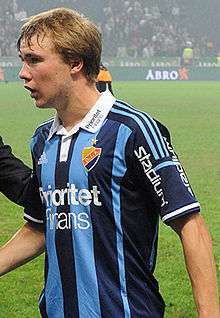Djurgårdens IF Fotboll
Djurgårdens IF Fotbollsförening – commonly known as Djurgårdens IF, Djurgården Fotboll (official name), Djurgården (IPA: [ˈjʉ̂ːrˌɡoːɖɛn]), and (especially locally) Djurgår'n (IPA: [ˈjʉ̌ː(r)ɡɔɳ]), Dif or DIF[upper-alpha 1] – is the association football department of Djurgårdens IF. Founded 1891 on the island Djurgården, the club's home ground is Tele2 Arena, situated in the Johanneshov district of Stockholm.
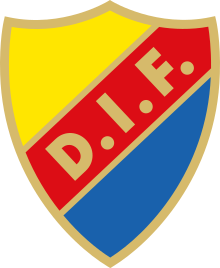 | ||||
| Full name | Djurgårdens IF Fotbollsförening | |||
|---|---|---|---|---|
| Nickname(s) | Järnkaminerna, Blåränderna, Stockholms stolthet, Diffen | |||
| Short name | Djurgår'n, DIF | |||
| Founded | 12 March 1891 1899 (football department) | |||
| Ground | Tele2 Arena, Stockholm | |||
| Capacity | 30,000 | |||
| Chairman | Lars-Erik Sjöberg | |||
| Head coach(es) | Kim Bergstrand & Thomas Lagerlöf | |||
| League | Allsvenskan | |||
| 2019 | Allsvenskan, 1st (champions) | |||
| Website | Club website | |||
|
| ||||
Competing in the highest Swedish tier, Allsvenskan, the club has won the league twelve times and the cup five times. The league titles have mainly been won during three separate eras. The first period was the 1910s, when they won four league titles. The second era occurred in the 1950s and 60s, when Djurgården also won the league four times. The most recent era was the first half of the 00s when they won both the league and the cup three times.
Fans of the club, called djurgårdare, are found all over Stockholm and Sweden. However, Östermalm, where Djurgården's former home ground Stadion is situated, is by some considered the club's heartland. Djurgården is affiliated to the Stockholms Fotbollförbund.[1]
History
Foundation
Djurgårdens IF was founded, primarily by John G. Jansson, on 12 March 1891 at a café in Alberget 4A in the island Djurgården. Most of the founding members were young working class men.[2] The club originally focused on winter sports and athletics. The first real football field in Stockholm was created in 1896. Djurgårdens IF's football department was formed in 1899, with the help of former GAIS player Teodor Andersson.[3] Djurgården played their first match in July 1899, a 1–2 loss against AIK.[3]
First era
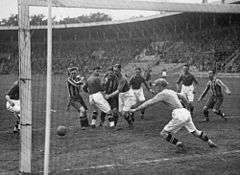
The first real achievement was made in 1902 when the team finished second in the tournament Rosenska Pokalen. Just two years later, in 1904, the first Swedish Championship final of the club was played, ending in a defeat against Örgryte IS. The team finished second in three more finals before the first Championship victory came in 1912 after two draws in the final matches against Örgryte, and a replay which Djurgården won. The club won three more Swedish Championships in the early years, in 1915 against Örgryte, 1917 against AIK and 1920 against IK Sleipner. However, DIF never managed to win Svenska Serien, the top Swedish league of the period, before the club's first great era ended. Between 1911 and 1935, Tranebergs Idrottsplats was the homeground for Djurgården. For the 1912 Summer Olympics, Stockholms Stadion was built. It became Djurgården's permanent home arena in 1936.
The club did not qualify for the first season of Allsvenskan, and only reached that league twice between 1924 and 1944, being directly relegated back down to Division 2 both times. The club did also play three seasons in the then third highest league, Division 3, between 1929 and 1932. From 1944 on, the club became a stable Allsvenskan club. In 1951, the team became runners-up in Svenska Cupen after Malmö FF; this was the team's first Cup final.
Second era

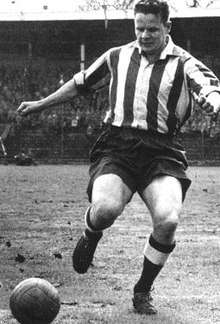
The second great era took place in the 1950s and 1960s, winning Allsvenskan four times during the period. Djurgården's fifth Swedish championships, and first Allsvenskan championship, was taken in the 1954–55 season under the lead of Frank Soo. In the 1955–56 season, Djurgården became the first Swedish team to enter the European Cup.[3] Beating Gwardia Warszawa in the first round, Djurgården advanced to quarter finals against Scottish Hibernian that they lost by 1–4 over two matches.[3]
In 1959, both the football team and Djurgårdens IF's hockey team won their respective Swedish Championships of Sweden's two most popular sports, a remarkable happening. The 1959 title was secured on Råsunda Stadium, in front of 48,894 people, marking a record attendance for Djurgården, with a team of Sven Tumba, Birger Eklund, Lars Broström, John Eriksson, Hans Karlsson, Gösta Sandberg, Olle Hellström, Stig Gustafsson, Arne Arvidsson, Hans Mild and Sigge Parling.[3]
The year after, in the 1960 season Djurgården finished 11th and was relegated to Division 2. The team only needed one year to return to Allsvenskan. In 1964 and 1966, Djurgården took its seventh and eight championships, with 1966 marking the end of the career of Gösta Sandberg.[3] Sandberg played 322 league matches for the team 1951–66 and scored 77 goals. Gösta Sandberg is known as "Mr Djurgården" and was in 1991 named "Djurgårdare of the century". Sandberg also played for the club's Bandy and Ice Hockey section. He died on his way home after attending the Tvillingderbyt in 2006.
It's during this era that the nickname "Järnkaminerna" ("The Iron Furnaces") was established, due to the club's physical playing style. The ideal of a strong and uncomprimising Djurgården player might also be traced back to the club's working-class roots.[2]
Middle years
The 1970s saw no greater successes; however, Djurgården was steady in Allsvenskan and had three third-places and a final loss in the 1975 Svenska Cupen Final as the best results. Gary Williams became the first foreign player in the team in the 1977 season.

The 1980s was not a good decade for the club, being relegated from Allsvenskan in 1981, and losing two promotion play-offs, before making a one-year visit in the highest league in 1986, although DIF returned two years later, and stayed in Allsvenskan for five consecutive seasons, but had no greater success except losing the Championship final in 1988. In 1987, Djurgårdens IF Fotboll presented a 12 million SEK deficit and later transformed into an aktiebolag.[4] Former England striker Teddy Sheringham had a brief spell at Djurgården early in his career, as a 19-year-old loanee in 1985.
The 1990s saw Djurgården being relegated from Allsvenskan no less than three times, and being promoted back two times. During this decade, the club suffered from great economical problems and was close to bankruptcy. The 1995 season started well, but ended badly; in the last home match of the 1995 Allsvenskan, a supporter, later named Terror-Tommy in media, came on pitch and kicked referee Anders Frisk.[3]
Third era
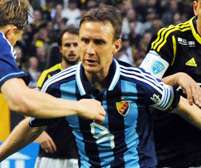
In the middle of 1999 season, Zoran Lukic and Sören Åkeby took over the team and won the inaugural 2000 Superettan and finished 2nd as newly promoted in the 2001 Allsvenskan. With a team consisting of Stefan Rehn, Kim Källström, Andreas Johansson, and Andreas Isaksson, Djurgården secured its first title in 36 years in the last round of the 2002 Allsvenskan.[3] The first half of the 2000s was a golden era for the club, with three championships (2002, 2003 and 2005) and three cup wins (2002, 2004 and 2005). This marked the end of the golden era for Djurgården, which ended on sixth place in 2006. The club was one of the main contenders for the league championship in 2007, which ultimately lead to a third place.
Present day
The results went downhill in 2008 and 2009; Djurgården ended up in 14th place in 2009, and had to play through a relegation playoff against Assyriska Föreningen to remain in Allsvenskan. In the early 2010s, Djurgården was a mid-table Allsvenskan team finishing 7th to 11th between 2010 and 2014. When the newly appointed Director of sport Bo Andersson who led Djurgården to three titles in the early 21st century came back in 2014 he was forced to sell players such as Daniel Amartey (who became the most expensive defender ever sold by an Allsvenskan club for about 25 million SEK), Erton Fejzullahu, Christian Rubio Sivodedov and Simon Tibbling which stabilized the financials.
In January 2017, Djurgården sold the Kenyan international forward Michael Olunga for a club record fee of 40 million SEK which made the club's financial positions one of the best in the country. The transfer also made it possible to sign club legend Kim Källström and fellow former Swedish international Jonas Olsson. Both players, together with recently returned goalkeeper Andreas Isaksson, played important roles as Djurgården finished in third place in the 2017 allsvenskan, qualifying for the second qualifying round for the 2018–19 UEFA Europa League for the first time in ten years. After 13 years without a title Djurgården won the Svenska Cupen (Swedish Cup) on 10 May 2018 going through the Cup scoring 14 goals and not conceding a single goal.
In 2019 they won the league title for the first time in fourteen years (2005). They secured the title on the last day of the season after a 2-2 draw away from home against IFK Norrköping. This means they will try to qualify for champions league in the 20/21 season.
Supporters
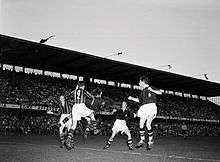
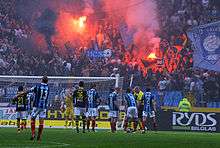
Djurgården is one of the most supported clubs in Sweden, with most of its supporters living in Stockholm and the neighbouring suburbs.[5] Traditionally the Östermalm district is considered to be the club's stronghold. No reliable research exists about the spread of Djurgården supporters, but a 2015 T-shirt campaign suggests that supporters are spread fairly evenly throughout the Stockholm area.[6]
Although Djurgården's supporters have been organizing themselves since the late 1940s, with the founding of DIF Supporters Club back in 1947, the 1970s saw singing supporter sections emerging which led to a new supporter club to be founded in 1981, named Blue Saints.[7][8] The supporter club later changed its name in 1997 to Järnkaminerna (lit. the Iron Furnaces) since the old name was perceived to be associated with violence. Järnkaminerna is Djurgården's official supporters' group with a membership of a few thousand.
The 2000s saw the emergence and creation of independent ultras groups. The oldest active ultra group, Ultra Caos Stockholm, formed in 2003 is largely influenced by southern European supporter culture.[9]
In 2005 Fabriken Stockholm was formed and took over the role of creating tifos for the team's games from a former, now abolished group, Ultras Stockholm, founded in the late 1990s. In 2013 a larger and more open organization was started and took charge of the terrace choreography, headed by Ultra Caos Stockholm.
Notable Djurgården supporters
- Fredrik Reinfeldt, former Prime Minister of Sweden
- Joakim Thåström,[10] musician
- Stefan Persson, former CEO, Chairman of the Board and major shareholder of H&M[11]
- Christer Fuglesang,[12] astronaut, first Scandinavian in space
Rivalries
Djurgården's archrival is AIK due to several reasons. AIK was founded February 15th 1891, while Djurgården was founded March 12th, just four weeks later, both in Stockholm City Centre. Because of this, games between the teams are called Tvillingderbyt (lit. Derby of the twins) by the media, a name that hasn't caught on amongst supporters since they don't view themselves as twins and want no affiliation with one another.
Games between the two teams are very popular and draw large attendances. The games can often be heated occasions given the fact that there is a lot of animosity between both sets of supporters and can produce great atmospheres. They are also historically the biggest and most successful clubs from Stockholm, with 21 titles won by AIK and 17 by Djurgården.
Hammarby is the other main rival, mostly because of the geographical proximity with Djurgården having its stronghold in the Östermalm district of Stockholm and Hammarby considering Södermalm, also in central Stockholm, its heartland. Since 2013, the two teams share the same home ground: Tele2 Arena.
Affiliated clubs and schools
Affiliated clubs
- Division 2
- Konyaspor KIF[13]
- Håbo FF
- Division 3
- IFK Lidingö FK
- Spårvägens FF
- Division 4
- Kista Sports Club
- Rågsveds IF
On 22 May 2016, Djurgården announced a cooperation with Spårvägens FF as part of strengthening the presence of Djurgården in the southern suburbs of Stockholm as for example Skarpnäck, Bagarmossen and Skölndal. One of the aims of the cooperation is to make a natural way for talents in southern Stockholm to become a part of Djurgården. On 4 August 2016 a similar cooperation with Kista Sports Club was announced.
Kit
The home shirt is vertically striped in sky and dark blue. The shorts are usually dark blue but have some years been white.
Kit manufacturers and sponsors
The club's kit manufacturer Adidas presents a new kit every other (even) year. Apart from Adidas, Djurgården has the logos of the following companies visible on their shirt and shorts: Prioritet Finans, a financial-services company; Stadium, a sporting-goods retail chain; Erlandsson, a construction company; ABT Bolagen, another construction company; German automakers Volkswagen; NRC Group, a rail-infrastructure contractor; and league sponsors Svenska Spel, a government-owned gambling company (whose logo is on the right sleeve of the shirts of all Allsvenskan teams).
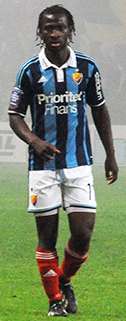
| Period | Kit manufacturer | Shirt sponsor (chest) |
|---|---|---|
| 1976–1979 | None | |
| 1980 | MasterCharge | |
| 1981 | Köpkort | |
| 1982 | None | |
| 1983 | Atari | |
| 1984–1987 | Året Runt | |
| 1988 | QC Business Card | |
| 1989–1992 | Mita Copiers | |
| 1993 | ICA | |
| 1994–1996 | Graphium | |
| 1997 | "Nej till våld och droger!" | |
| 1998 | HP | |
| 1999 | Bewator | |
| 2000–2004 | Kaffeknappen | |
| 2005–2012 | ICA | |
| 2013 | Djurgårdsandan | |
| 2014– | Prioritet Finans |
Stadiums


Djurgården's primary stadium since 2013 is Tele2 Arena. The club's first match at the new arena was the 1–2 defeat to IFK Norrköping on 31 July 2013, with an attendance of 27,798 people, which also counts as Djurgården's record attendance on the arena.
Between 1936 and 2013, Djurgården's primary stadium was Stockholm Olympic Stadium, where the national league and cup games were played. The secondary stadium was Råsunda Stadium, where Stockholm derbies against AIK and Hammarby IF were played. The old Olympic Stadium, built in 1912, didn't fulfill UEFA's stadium requirements and therefore international cup games were also played at Råsunda. The club's record attendance at the Olympic Stadium is at least 21,995 against AIK on 16 August 1946.[14][upper-alpha 2] Djurgården's record attendance at Råsunda is 48,894 against IFK Göteborg on 11 October 1959.[15]
The club's first stadium was Stockholms idrottspark where the club played from 1899 when the football department was founded until 1906 when the club moved to the newly built Östermalm Athletic Grounds.[16] Djurgården did not stay long at Östermalm, in August 1910 the club signed a 25-year contract with the Stockholm City Council to dispose of an area in Traneberg, a district west of the inner city, to build a stadium.[17] Tranebergs Idrottsplats was finished in October 1911 and inaugurated by Crown Prince Gustaf Adolf.[17] The contract expired in 1935, and the City Council intended to build a residential area where the stadium was situated. Djurgården therefore moved to the Stockholm Olympic Stadium in 1936, where the club had played previously on several occasions since it was finished in 1912.[18]
The later half of the 1940s saw a significant increase in attendances, which led the club to play some games at the larger, more modern, Råsunda Stadium.[19][20] As Djurgården climbed in the league table in the beginning of the 1950s, all games were played at Råsunda.[20] The end of the 1960s saw a return to the Olympic stadium, and soon all games were played there, with the exception of derbies.[20]
The club's achievements in the early 2000s drew large attendances with led Djurgården to plan for a new stadium. The old 1912 Olympic Stadium also lacked modern facilities and individual seats. Along with political promises in 2006, Djurgården aimed for a rehaul of Stockholm Olympic Stadium and later an entirely new stadium at Östermalm Athletic Grounds.[21][22][23] These plans were abandoned in December 2011 due to the building costs exceeding the club's financial capabilities.[24] New stadium requirements from the Swedish Football Association also did not allow Djurgården to play at the Olympic Stadium after 2013.[25] Thus, the club board made the decision to move to Tele2 Arena for the 2013 season.[26]
Youth academy
The youth academy is located at Hjorthagens IP. In December 2012 an indoor arena named "Johan Björkmans hall" with one full-size turf, and two smaller turfs was built at Hjorthagens IP which enables football training all year around.[27] In 2007 Djurgården invested 65 million SEK (roughly 7 million Euro) for the upcoming five years in their youth academy. This project was described as a unique investment by a Swedish club by the former director of sports, Göran Aral.[28] In 2015 the training ground for the first team was renovated which enabled the U-19 and U-17 teams to be training at Kaknäs IP and therefore come closer to the first team. The academy has produced players like Simon Tibbling, Emil Bergström and Christian Rubio Sivodedov.
Players
First-team squad
- As of 13 June 2020[29]
Note: Flags indicate national team as defined under FIFA eligibility rules. Players may hold more than one non-FIFA nationality.
|
|
Out on loan
Note: Flags indicate national team as defined under FIFA eligibility rules. Players may hold more than one non-FIFA nationality.
|
|
Notable players
List criteria:
- player has been named Allsvenskan Top Goalscorer of the year,[30] or
- player has won Guldbollen,[31] or
- player is one of the 12 players named as "DIF-heroes" on the official club website.[32] or
- player has gained 100 caps or more for his country.
| Name | Nationality | Djurgården career |
Total appearances |
Total goals |
Guldbollen | Allsvenskan top goalscorer |
100 international caps |
|---|---|---|---|---|---|---|---|
| Hasse Jeppson | Sweden | 1948–51 | 51 | 58 | 1951 | ||
| Sigge Parling | Sweden | 1949–60 | 200 | 12 | |||
| Gösta Sandberg | Sweden | 1951–66 | 328 | 79 | 1956 | ||
| John Eriksson | Sweden | 1951–60 | 123 | 72 | |||
| Arne Arvidsson | Sweden | 1952–65 | 269 | 0 | |||
| Hans Mild | Sweden | 1957–65 | 160 | 6 | 1964 | ||
| Olle Hellström | Sweden | 1957–64 1968 |
129 | 4 | |||
| Leif Skiöld | Sweden | 1960–65 | 75 | 60 | 1962 | ||
| Ronney Pettersson | Sweden | 1960–70 | 123 | 0 | |||
| Sven Lindman | Sweden | 1965–68 1969–80 |
326 | 49 | |||
| Tommy Berggren | Sweden | 1968–84 | 299 | 55 | 1978 | ||
| Vito Knežević | Sweden | 1977–88 | 242 | 18 | |||
| Leif Nilsson | Sweden | 1984–92 | 215 | 5 | |||
| Stefan Rehn | Sweden | 1984–89 2000–02 |
210 | 52 | |||
| Andreas Isaksson | Sweden | 2001–04 2016–2018 |
163 | 0 | Yes | ||
| Kim Källström | Sweden | 2002–03 2017 |
96 | 34 | Yes | ||
| Magnus Eriksson | Sweden | 2016–17 | 49 | 17 | 2017 | ||
| Mohamed Buya Turay | Sierra Leone | 2019 | 29 | 15 | 2019 |
Management and boardroom
Management
As of 8 January 2019[29]
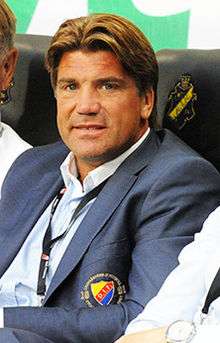
|
Boardroom
As of 6 March 2019[33]
|
Managerial history
It is not known for sure who was the team's manager until 1922, though it is believed that Birger Möller was in charge during a part of the club's first decades.[34]
|
|
Kjell Jonevret is the manager who most recently won the league with Djurgården (in 2005).  Gösta Sandberg became manager in 1967, the year after he retired as a player for the club.
|
Honours
- Swedish Champions[upper-alpha 4]
League
Cups
- Svenska Cupen:
- Svenska Mästerskapet:
- Allsvenskan play-offs:
- Runners-up (1): 1988
- Corinthian Bowl:
- Rosenska Pokalen:
- Runners-up (1): 1902
- Wicanderska Välgörenhetsskölden:
- Nordic Cup:
Records
- Victory, Allsvenskan: 9–1 vs. Hammarby IF (13 August 1990)
- Loss, Allsvenskan: 1–11 vs. IFK Norrköping (14 October 1945)
- Highest attendance, Råsunda Stadium: 48,894 vs. IFK Göteborg (11 October 1959)
- Highest attendance, Stockholms Stadion: 21,995 vs. AIK (16 August 1946)
- Highest attendance, Tele2 Arena: 28,258 vs. Örebro SK (28 October 2019)[38]
- Most appearances, Allsvenskan: 312, Sven Lindman (1965–80)
- Most goals scored, Allsvenskan: 70, Gösta 'Knivsta' Sandberg (1951–66)
- Record transfer fee paid – 14 million Swedish krona, Thiago Quirino from Atlético Mineiro (winter of 2006)
- Record transfer fee received – 50 million Swedish krona, Marcus Danielson to Dalian Professional (winter of 2020)
Most appearances
Competitive matches only, includes appearances as substitute. Numbers in brackets indicate goals scored.
| # | Name | Years | League | Cup | Europe | Other | Total |
|---|---|---|---|---|---|---|---|
| 1 | 1951–1966 | 322 (77) | 0 (0) | 6 (1) | 0 (1) | 328 (79) | |
| 2 | 1965–1968 1969–1980 |
312 (49) | 2 (0) | 12 (0) | 0 (0) | 326 (49) | |
| 3 | 1968–1984 | 289 (54) | 0 (0) | 8 (0) | 2 (1) | 299 (55) | |
| 5 | 1971–1982 1993 |
265 (0) | 0 (0) | 9 (0) | 2 (0) | 276 (0) | |
| 4 | 1952–1965 | 263 (0) | 0 (0) | 6 (0) | 0 (0) | 269 (0) | |
| 6 | 2003–2012 | 205 (27) | 20 (11) | 10 (0) | 10 (1) | 245 (39) | |
| 7 | 1977–1988 | 236 (17) | 0 (0) | 0 (0) | 6 (1) | 242 (18) | |
| 8 | 2000–2011 | 195 (1) | 16 (0) | 14 (0) | 12 (0) | 237 (1) | |
| 9 | 2000–2005 2013–2014 |
172 (50) | 30 (16) | 14 (4) | 3 (0) | 219 (70) | |
| 10 | 2003–2009 | 165 (6) | 19 (2) | 15 (0) | 17 (1) | 216 (9) |
Footnotes
- In the media, "Djurgårdens IF" is normally abbreviated "Dif", in accordance with Swedish writing standards that state that acronyms that are pronounced as a word, as opposed to letter by letter, should be spelled with the first letter in upper case and the remaining in lower case, thus "Dif". However, some fans of the club, as well as the club itself, prefer to use only uppercase, "DIF", even though they also pronounce it as a word: [diːf].
- Djurgården's record at Stockholm Olympic Stadium is disputed. Gänger, 2006, suggest the attendance was 21,995 while Rehnberg, 1991, suggest it was 22,108.[15]
- Ball was fired before Allsvenskan started.
- The title of "Swedish Champions" has been awarded to the winner of four different competitions over the years. Between 1896 and 1925 the title was awarded to the winner of Svenska Mästerskapet, a stand-alone cup tournament. No club were given the title between 1926 and 1930 even though the first-tier league Allsvenskan was played. In 1931 the title was reinstated and awarded to the winner of Allsvenskan. Between 1982 and 1990 a play-off in cup format was held at the end of the league season to decide the champions. After the play-off format in 1991 and 1992 the title was decided by the winner of Mästerskapsserien, an additional league after the end of Allsvenskan. Since the 1993 season the title has once again been awarded to the winner of Allsvenskan.[36]
References
- Gänger, Hasse (2007). Djurgårdens IF Fotboll 1899–2006 (in Swedish). Stockholm: Djurgårdens IF Fotboll. ISBN 978-91-633-0992-2.
- Hagström, Magnus; Johansson, Peter; Jurell, Carl (2010). Vad för jävla pack e ni? (in Swedish). Imperial Publishing. ISBN 978-91-978734-0-6.
- Rehnberg, Bo (ed.); Wickman, Mats (ed.) (1991). Djurgårdens IF 100 år: 1891–1991 (in Swedish). Sellin & Partner förlag. ISBN 91-7055-029-8.CS1 maint: extra text: authors list (link)
- "Kontaktuppgifter och tävlingar – Stockholms Fotbollförbund – Svenskfotboll.se". Retrieved 13 January 2011.
- Andersson, Torbjörn (2002) "Kung fotboll: den svenska fotbollens kulturhistoria från 1800-talets slut till 1950".
- Cederquist, Jonas (2010). Stockholms fotbollshistoria 1880–2010 [History of Football in Stockholm 1880–2010] (in Swedish). Stockholmia förlag. ISBN 978-91-7031-222-9.
- "Årets football 1988" [1988 Football of the year]. Cite journal requires
|journal=(help) - "AIK, DIF och Hammarby – hur ser supportrarna ut egentligen? – MEC Sverige". MEC Sverige. Archived from the original on 31 August 2013.
- "Leaderbord T-shirts DIF Stockholm". Google Docs.
- Hagström p. 55
- Hagström p. 67
- "Om oss" (in Swedish). Ultra Caos Stockholm. Archived from the original on 17 November 2010. Retrieved 17 December 2011.
- "Thåström håller på Dif". expressen.se. Retrieved 11 April 2017.
- "H&M-miljardären öppnar för att satsa i Djurgården" (in Swedish). Fotbollskanalen. 8 May 2015. Retrieved 8 May 2015.
- "Djurgården får stöd – från rymden". Aftonbladet (in Swedish). 28 May 2009. Retrieved 21 April 2014.
- "DIF Fotboll – DIF och Konyaspor blir samarbetsklubbar – DIF Fotboll". DIF Fotboll.
- Gänger, p. 216.
- Rehnberg, p. 444.
- Rehnberg, p. 288.
- Rehnberg, pp. 43–44.
- Rehnberg, p. 67.
- Gänger, pp. 215–219.
- "DIF:s hemmaarenor i Allsvenskan" (in Swedish). Djurgårdens IF Fotboll. Archived from the original on 13 August 2010. Retrieved 22 December 2011.
- "Arenafrågan – detta har hänt". Dagens Nyheter (in Swedish). 22 April 2009. Retrieved 6 January 2012.
- Riedel, Jonas. "Förslag till ny arena" (in Swedish). Djurgårdens IF Fotboll. Archived from the original on 19 February 2015. Retrieved 6 January 2012.
- Bengtsson, Janne (14 July 2010). "Djurgården närmare en ny arena". Svenska Dagbladet (in Swedish). Retrieved 6 January 2012.
- Ask, Erik (6 December 2011). "Djurgården lägger ner arenaplanerna". Dagens Nyheter (in Swedish). Retrieved 6 January 2012.
- "Rekommendationen: Stockholmsarenan 2013" (in Swedish). Djurgårdens IF Fotboll. Archived from the original on 19 January 2012. Retrieved 6 January 2012.
- Arnesen, Jonas (5 October 2011). "Stockholms-arenan blir Dif:s nya hem". Svenska Dagbladet (in Swedish). Retrieved 6 January 2012.
- "Djurgårdens nya superhall invigd". Fotbolldirekt (in Swedish). 2 December 2012. Retrieved 15 August 2016.
- "Djurgården satsar 65 miljoner på unga". SVT (in Swedish). 22 November 2007. Retrieved 15 August 2016.
- "Truppen" (in Swedish). Djurgårdens IF. Archived from the original on 4 February 2017. Retrieved 26 January 2016.
- "Allsvenska skyttekungar & publiksnitt 1925–". svenskfotboll.se (in Swedish). Retrieved 12 December 2011.
- "Guldbollen". svenskfotboll.se (in Swedish). Archived from the original on 3 April 2012. Retrieved 12 December 2011.
- "DIF-hjältar" (in Swedish). Djurgårdens IF Fotboll. Archived from the original on 25 August 2010. Retrieved 12 December 2011.
- "Styrelse" (in Swedish). Djurgårdens IF. Archived from the original on 6 August 2017. Retrieved 7 April 2017.
- Gänger, pp. 68–69
- "Historia" (in Swedish). Djurgårdens IF Fotboll. Archived from the original on 1 February 2012. Retrieved 12 December 2011.
- "Svenska mästare 1896–1925, 1931–". svenskfotboll.se (in Swedish). Retrieved 25 November 2009.
- "Finsk seger på straff mot Djurgården i cupen", Svenska Dagbladet, Stockholm, p. 13, 1 August 1962
- https://www.svt.se/sport/fotboll/djurgarden-5
External links
| Wikimedia Commons has media related to Djurgårdens IF Fotboll. |
- Official websites
- Djurgården Fotboll – official site
- Djurgården Fotboll – at the UEFA official site
- Djurgården Fotboll – at the Allsvenskan official site
- Supporter websites
- Järnkaminerna Stockholm – official supporter club site
- Djurgårdens Supporters Club – supporter site
